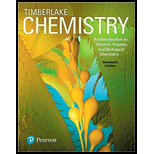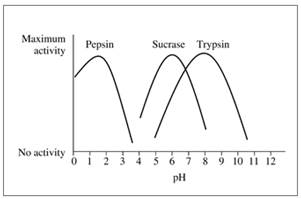
Chemistry: An Introduction to General, Organic, and Biological Chemistry (13th Edition)
13th Edition
ISBN: 9780134421353
Author: Karen C. Timberlake
Publisher: PEARSON
expand_more
expand_more
format_list_bulleted
Concept explainers
Textbook Question
Chapter 16.5, Problem 16.46PP
The following graph shows the activity versus pH curves for pepsin, sucrase, and trypsin. Estimate the optimum pH for each.

16.46 Refer to the graph in problem 16.45 to determine if the reaction rate in each condition will be at the optimum rate or not.
- Trypsin, pH 5.0
- Sucrase, pH 5.0
- Pepsin, pH 4.0
- Trypsin, pH 8.0
- Pepsin, pH 2.0
Expert Solution & Answer
Want to see the full answer?
Check out a sample textbook solution
Students have asked these similar questions
40) Use the following information to answer the question below.
+100-
19.0
+80
+70-
+6.0
+50-
+4.0
+3.0-
+20-
+1.0
+2.0
+4.0
+6.0
+80
+120
-10
Concentration of reactants. inicremolar
Rate of an enzyme-catalyzed reaction as a function of varying reactant concentration, with the concentration
of enzyme constant
In the figure, why does the reaction rate plateau at higher reactant concentrations?
A) The rate of the reverse reaction increases at high reactant concentrations.
B) Feedback inhibition by product occurs at high reactant concentrations.
C) The reaction nears equilibrium at high reactant concentrations.
D) Most enzyme molecules are occupied by substrate at high reactant concentrations.
Rate of product formation
The following grap shows the relationship between enzyme activity and both pH and temperature for two enzymes (A and B).
Based on this graphical information
What is the optimum pH for enzyme A?
What is the optimum temperature for enzyme B?
Which enzyme has the greater activity at a pH of 4?
Which enzyme has the greater activity at a temperature of 37.8°C?
What do we mean when we say an enzyme is saturated with substrate? When an enzyme is saturated with substrate, how does adding more (a) substrate and (b) enzyme affect the rate of the reaction?
Chapter 16 Solutions
Chemistry: An Introduction to General, Organic, and Biological Chemistry (13th Edition)
Ch. 16.1 - Classify each of the following proteins according...Ch. 16.1 - Prob. 16.2PPCh. 16.1 - Prob. 16.3PPCh. 16.1 - Prob. 16.4PPCh. 16.1 - Draw the structure for each of the following amino...Ch. 16.1 - Draw the structure for each of the following amino...Ch. 16.1 - Draw the strcture for each of the following amino...Ch. 16.1 - Prob. 16.8PPCh. 16.1 - Prob. 16.9PPCh. 16.1 - Prob. 16.10PP
Ch. 16.2 - Prob. 16.11PPCh. 16.2 - Prob. 16.12PPCh. 16.2 - Prob. 16.13PPCh. 16.2 - Prob. 16.14PPCh. 16.2 - Prob. 16.15PPCh. 16.2 - Prob. 16.16PPCh. 16.3 - Prob. 16.17PPCh. 16.3 - Prob. 16.18PPCh. 16.3 - Prob. 16.19PPCh. 16.3 - Prob. 16.20PPCh. 16.3 - What type of interaction would you expect between...Ch. 16.3 - What type of interaction would you expect between...Ch. 16.3 - Prob. 16.23PPCh. 16.3 - Prob. 16.24PPCh. 16.3 - Prob. 16.25PPCh. 16.3 - Prob. 16.26PPCh. 16.3 - Prob. 16.27PPCh. 16.3 - Indicate the changes in secondary and tertiary...Ch. 16.4 - Why do chemical reactions in the body require...Ch. 16.4 - Prob. 16.30PPCh. 16.4 - Prob. 16.31PPCh. 16.4 - Prob. 16.32PPCh. 16.4 - Prob. 16.33PPCh. 16.4 - Prob. 16.34PPCh. 16.4 - Prob. 16.35PPCh. 16.4 - 16.36 Match the terms (1) active site, (2)...Ch. 16.4 - Prob. 16.37PPCh. 16.4 - Prob. 16.38PPCh. 16.4 - Prob. 16.39PPCh. 16.4 - Prob. 16.40PPCh. 16.4 - For problems 16.39 to 16.42, see Chemistry Link to...Ch. 16.4 - Prob. 16.42PPCh. 16.5 - Trypsin, a peptidase that hydrolyzes polypeptides,...Ch. 16.5 - pepsin, a peptidase that hydrolyzes proteins,...Ch. 16.5 - The following graph shows the activity versus pH...Ch. 16.5 - The following graph shows the activity versus pH...Ch. 16.5 - Prob. 16.47PPCh. 16.5 - Prob. 16.48PPCh. 16.5 - Prob. 16.49PPCh. 16.5 - Prob. 16.50PPCh. 16.5 - What is the chemical formula for hydroxyurea?Ch. 16.5 - What is the molar mass of hydroxyurea?Ch. 16.5 - Prob. 16.53PPCh. 16.5 - Prob. 16.54PPCh. 16 - Prob. 16.55UTCCh. 16 - Prob. 16.56UTCCh. 16 - Prob. 16.57UTCCh. 16 - Prob. 16.58UTCCh. 16 - 16.59 Identify the amino acids and type of...Ch. 16 - What type of interaction would you expect between...Ch. 16 - Draw the condensed structural formula for...Ch. 16 - Draw the condensed structural formula for...Ch. 16 - Seed and vegetables are often deficient in one or...Ch. 16 - 16.64 Seeds and vegetables are often deficient in...Ch. 16 - Prob. 16.65APPCh. 16 - Prob. 16.66APPCh. 16 - Prob. 16.67APPCh. 16 - Prob. 16.68APPCh. 16 - Prob. 16.69APPCh. 16 - Why do enzymes function only under mild...Ch. 16 - Prob. 16.71APPCh. 16 - Prob. 16.72APPCh. 16 - Prob. 16.73APPCh. 16 - Prob. 16.74APPCh. 16 - Prob. 16.75APPCh. 16 - Prob. 16.76APPCh. 16 - Prob. 16.77APPCh. 16 - Prob. 16.78APPCh. 16 - If a blood test indicates a high level of LDH and...Ch. 16 - Prob. 16.80APPCh. 16 - Prob. 16.81CPCh. 16 - Prob. 16.82CP
Knowledge Booster
Learn more about
Need a deep-dive on the concept behind this application? Look no further. Learn more about this topic, chemistry and related others by exploring similar questions and additional content below.Similar questions
- When handling or storing solutions of enzymes, the pH is usually kept near 7.0. Explain why.arrow_forward3. Some medications permanently inactivate their target enzyme by forming a covalent bond to an amino acid in the enzyme's active site. Aspirin is one example of a pharmaceutical that uses this type of mechanism. So is penicillin. As you saw in the last chapter, the active portion of penicillin is the B-lactam ring. Penicillin forms a covalent bond to serine in the active site transpeptidase, an enzyme that is essential for forming the bacterial cell wall. Propose a mechanism for the inactivation of transpeptidase by penicillin and show the final product of the reaction. NH OH CH3 CH2 CH3 backbone penicillin serinearrow_forwardJuan performed the same chemical reaction twice. His data from the first at- tempt is indicated by the red line. His data from the second attempt is indicated by the blue line. Energy During a Chemical Reaction Energy A B reactants e.g. C6H12O6 + O₂ C without enzyme Juan added pressure. with enzyme Reaction coordinate What change did Juan most likely make to his reaction the second time he per- formed it? activation energy with enzyme D Juan added a catalyst. Juan increased the surface area of the reactants. Juan cooled his reactants. activation energy without enzyme overall energy released during reaction products CO,+H,Oarrow_forward
- 10. Factor In the enzyme catalyzed reaction depicted above, which factor could be changed (increased) to produce the graph? (Assume an unlimited substrate supply and change in the factor) a. inhibitor concentration Ob. temperature Oc. pH Od. enzyme concentrationarrow_forwardThe above diagram illustrates ___? The relationship between the proteome and the metabolome The relationship between the concentration of enzymes and the rate of chemical reactions they catalyze a and barrow_forwardEnzymes that are rather aggressive, and turned "off" by a protein segment until they are activated. е.arrow_forward
- Which of the following produce heat 1 - labile enterotoxin which can be damaged by food boiling 1 Clostridium boltulinum Vibrio cholerae Staphylococcus aureus Enterotoxigenic Escherichia coli all except staphylococcus aureus are correct Which of the following produce heat *1/1 -labile enterotoxin which can be damaged by food boiling Clostridium boltulinum Vibrio cholerae Staphylococcus aureus Enterotoxigenic Escherichia coli all except staphylococcus aureus are correctarrow_forwardWhich statement concerning the effectiveness of enzymes is NOT true? Select one: O An enzyme may not function outside a certain pH range. O The effectiveness of an enzyme is likely to vary over a range of temperatures. O Although the actions of different enzymes may vary, the effectiveness of each particular enzyme is constant. Enzymes are affected by salt concentration.arrow_forward13. A specific enzyme will usually only catalyze one particular reacton. True Falsearrow_forward
- A non-substrate molecule binds to an enzyme at the active site, causing the enzyme to stop working temporarily. This is an example of _ . reversible competitive inhibition negative allosterism positive allosterism reversible non-competitive inhibition 3 of these 4 responses are correctarrow_forwardWhat is the effect of an enzyme on the activation energy ofa reaction?arrow_forward6. What is the instantaneous reaction rate for an enzyme system? k = 0.087 1/h; enzyme concentration = 0.02 M; substrate concentration = 0.05 M; and Km concentration = 0.01 M? Answer should be in units of mM/harrow_forward
arrow_back_ios
SEE MORE QUESTIONS
arrow_forward_ios
Recommended textbooks for you
 Introduction to General, Organic and BiochemistryChemistryISBN:9781285869759Author:Frederick A. Bettelheim, William H. Brown, Mary K. Campbell, Shawn O. Farrell, Omar TorresPublisher:Cengage Learning
Introduction to General, Organic and BiochemistryChemistryISBN:9781285869759Author:Frederick A. Bettelheim, William H. Brown, Mary K. Campbell, Shawn O. Farrell, Omar TorresPublisher:Cengage Learning Chemistry for Today: General, Organic, and Bioche...ChemistryISBN:9781305960060Author:Spencer L. Seager, Michael R. Slabaugh, Maren S. HansenPublisher:Cengage Learning
Chemistry for Today: General, Organic, and Bioche...ChemistryISBN:9781305960060Author:Spencer L. Seager, Michael R. Slabaugh, Maren S. HansenPublisher:Cengage Learning

Introduction to General, Organic and Biochemistry
Chemistry
ISBN:9781285869759
Author:Frederick A. Bettelheim, William H. Brown, Mary K. Campbell, Shawn O. Farrell, Omar Torres
Publisher:Cengage Learning

Chemistry for Today: General, Organic, and Bioche...
Chemistry
ISBN:9781305960060
Author:Spencer L. Seager, Michael R. Slabaugh, Maren S. Hansen
Publisher:Cengage Learning
DIGESTER-35 | VITAMINS AND THEIR RELATED COENZYMES| GPAT | NIPER | PHARMACIST| DI; Author: GPAT DISCUSSION CENTER;https://www.youtube.com/watch?v=CGrdNYmho0s;License: Standard YouTube License, CC-BY